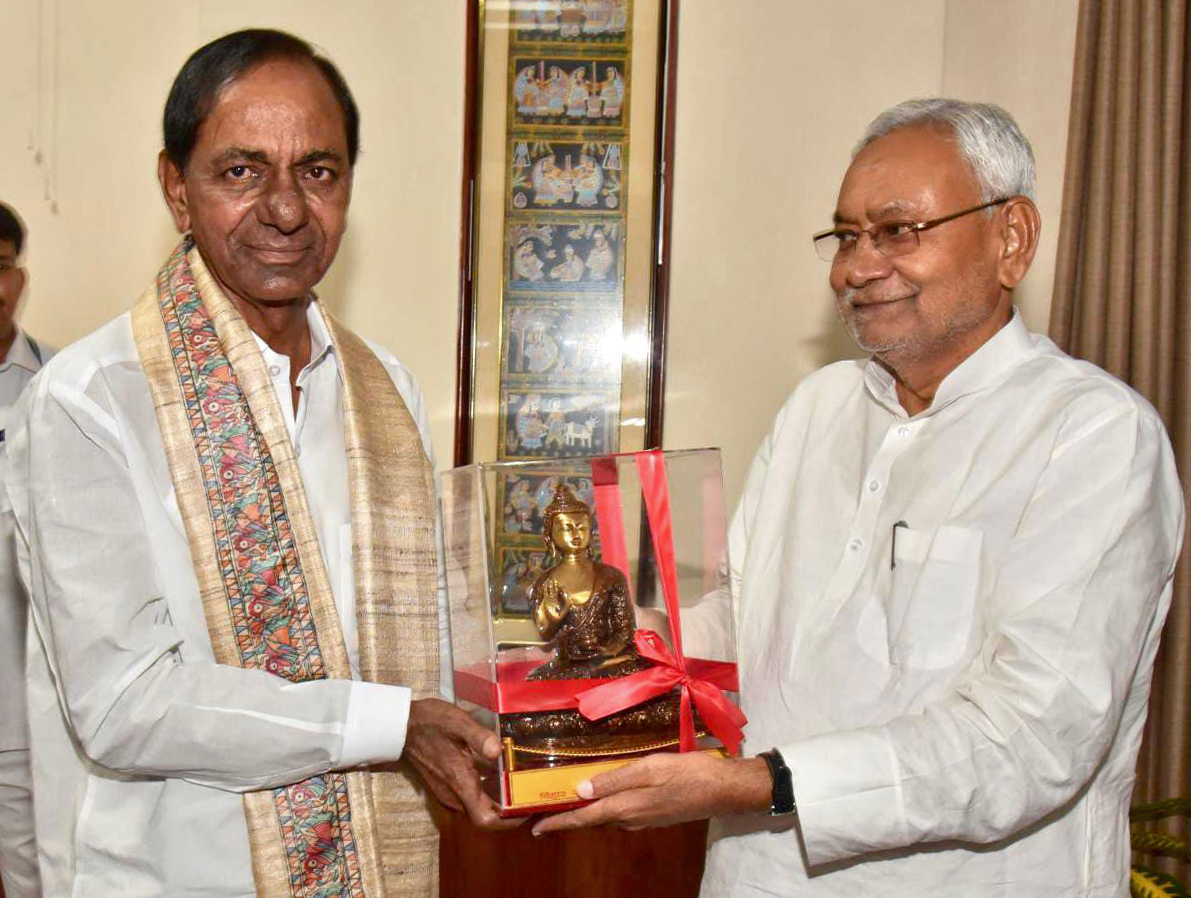NEW DELHI: For the first time in his political avatar as the president of a regional party and as a Prime Minister aspirant for the 2024 elections, Telangana Chief Minister K. Chandrashekhar Rao, who is also the president of the Telangana Rashtra Samithi (TRS), on Thursday went to Patna and met Bihar Chief Minister Nitish Kumar, who like Rao, is also being propped up by his own set of dedicated supporters as the next PM candidate.
While supporters of Nitish Kumar, K. Chandrashekhar Rao and Mamata Banerjee are projecting their respective leaders as the combined Opposition’s Prime Minister face for 2024, the reality is that without the Congress winning at least 100 Lok Sabha seats and deciding to support any of the many PM aspirants, the “united” Opposition is in no position to mount a serious electoral challenge to the BJP led by Prime Minister Narendra Modi.
Bihar, Jharkhand and Tamil Nadu are the three states that presently have a non-BJP, non-Congress Chief Minister and which are also a part of the Congress-led United Progressive Alliance (UPA). These three states send 93 Members of Parliament to Delhi. In all these three states, the Congress is a “minor” partner for years now.
Apart from these three, there are seven other non-BJP, non-Congress ruled states and Union Territories that are neither a part of the UPA nor of the BJP-led National Democratic Alliance (NDA). They are West Bengal, Odisha, Andhra Pradesh, Delhi, Kerala, Punjab and Telangana. These seven together have 145 Members of Parliament.
Of these seven, the Biju Janata Dal, which that is ruling Odisha (21 MPs) in the East, and YSRCP, which is ruling Andhra Pradesh (25 MPs) in the South, have time and again, through their stand on crucial issues in Parliament, made it clear that though they are not a part of the NDA, yet they will side with it when given an option to choose between the NDA and UPA.
Even if the voters of all these 10 states elected non-BJP and non-Congress MPs on all the 238 seats (93+145) in the 2024 elections, which is highly unlikely, then also 238 will fall sort of the magic figure of 272, which is needed to attain majority in the 543-seat Lok Sabha, by 34 seats.
The gap will widen even more if Odisha and Andhra Pradesh, which have 46 seats in total, are taken out of this equation. Then the number of seats that would be won (assuming their strike rate is 100%) by the anti-BJP parties in these eight non-BJP, non-Congress states would be 182 seats, 90 seats fewer than the majority mark of 272.
According to political observers, it is this inherent, limited reach of these regional parties which they cannot breach even if they achieve the impossible 100% strike rate in the 2024 Lok Sabha elections, that makes the Congress so important to the concept of a united national opposition to take on the BJP, which by all political estimates, is poised to win the 2024 elections, that are now just 18 months away.
Apart from these 10 states, the BJP and the Congress are in a direct fight in the remaining 18 states, especially in the belt of Madhya Pradesh, Rajasthan, Gujarat and Chhattisgarh that have 91 MPs. In Maharashtra, where there are 42 Lok Sabha seats, the highest after Uttar Pradesh, the Congress is a major player.
“It is an undisputed fact that the Congress is the only Opposition party in India that can win more than 100 seats in the Lok Sabha in 2024, despite its dismal performance in 2014 and 2019. The noise being made by the other Opposition leaders, including the West Bengal CM and other CMs, should be understood through two different angles—the first one is that it is meant for their state electorate, to enforce the theory that their CM is a ‘big’ leader, someone who can become the PM soon; and secondly, it is also a sort of preparation for putting Congress leaders under pressure by letting them know that in case a situation arises where the non-BJP parties get more seats in 2024 and the BJP is not in a situation to form government, then a regional leader should be offered the PM’s chair and it should not be kept by the Congress as a ‘default’. Ironically, these regional leaders don’t realise that for them to become the PM with 20-30 MPs from their party winning the election, the Congress has to cross at least 100 seats, which will then mean that the BJP will come down to fewer than 200 seats, thereby leading to its present formal allies and other informal allies like BJD and YSRCP abandoning it,” said a journalist, who has worked in multiple states for three decades with one of India’s leading dailies.
Regional leaders’ PM dreams depend on Congress crossing 100 seats
- Advertisement -

